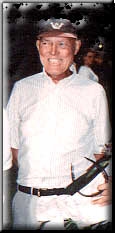Mesothelioma Can’t Keep a Good Man Down
Irrepressible 72 year-old Ted Hartley Bishop, who bears a passing resemblance to the late actor and director John Huston, loves exotica, and life, especially HIS life.
After spending three years serving his country in the United States Army, Ted returned home to Arizona and made plans to attend college. In 1954, he completed his studies at Duke University, receiving degrees in Economics and Civil Engineering. He headed back to Arizona and worked there for a few years, but soon the traveling bug hit him.
From the late 1950s to 1980, Ted worked as an engineer all over the world. He spent four years in Vietnam, three years in Bagdad, two years in Nevada, and then another seven years back in Vietnam. He owned his own civil engineering firm in Bangkok, Thailand, and spent thirteen years working in Saudi Arabia.
In November, 1998, Ted was found to have elevated glucose levels in his blood on routine screening, and told that he needed to start insulin. A proactive type, Ted could not believe that he was a diabetic. He knew that the pancreas made insulin, so he insisted upon a CT scan of his pancreas. The CT scan revealed three hypodense liver lesions, a 1.5 centimeter right adrenal gland abnormality, and what was felt to be an "apple core" mass in the ascending colon. A core liver biopsy reviewed by his doctors resulted in findings suggestive of peripheral T-cell lymphoma, compatible with Lennert's lymphoma. Ted underwent chemotherapy with ProMACE-CytaBOM. After three cycles, there was reduction in the liver nodules and the adrenal lesion was unchanged. After completion of all six cycles in May 1999, a CT scan showed stable disease.
However, follow-up CT scans continued to show abnormalities, and Ted underwent a repeat core liver biopsy in June, 1999. The diagnosis was changed to poorly differentiated carcinoma. The change in diagnosis caused Ted to lose confidence in his local doctors. He decided to consult with doctors at the medical center of his alma mater, Duke University.
On September 30, 1999, Ted met with Dr. Jon Paul Glockerman at Duke University Medical Center. As Dr. Glockerman noted, since the repeat liver biopsy in Arizona, "There has been much discussion . . . as to what his tumor is and what approach to take and in fact what disease is being treated. He has been seen by several surgeons, but they are reluctant to operate based on what the disease may be."
Dr. Glockerman felt that T-cell lymphoma was probably a misdiagnosis, because clinically it would be very atypical for T-cell lymphoma to be localized to the liver, as in Ted's case. He felt the tumor was more likely a carcinoma of unknown type to begin with, as often tumors in the initial stage will attract many lymphocytes and the sampling may have revealed only lymphocytes initially. Dr. Glockerman ordered tumor marker studies to attempt to determine the tumor type, and Ted returned to Arizona pending review.
In November, Ted returned to Duke, and after consulting with his doctors there, decided to undergo an exploratory laparoscopy. On November 17, 1999, Ted underwent the surgery, which was converted to an open liver and peritoneal mass biopsy and excision. The Chief Pathologist at Duke diagnosed epithelial peritoneal mesothelioma. The diagnosis was confirmed by the renowned Dr. Victor Roggli, professor of pathology at Duke University and Virginia Medical Centers, and a member of the Mesothelioma Applied Research Foundation (MARF). MARF aims to eradicate mesothelioma as a life-ending disease.
Fittingly, the mesothelioma disease process in this unique individual was itself unique. Given his tumor burden, Ted was relatively well. Dr. Glockerman felt that the pathology report diagnosing peritoneal mesothelioma described "a very rare process of which only a handful of cases have been reported." Dr. Glockerman reviewed the literature on Ted's type of mesothelioma, and found that there was very limited data on treatment options. Given his metastatic disease, Dr. Glockerman recommended treatment with the experimental cancer drug CPT 11.
Ted returned to Arizona to begin treatment at a cancer center with CPT 11, but his oncologists there questioned the diagnosis. Ted helped obtain and deliver the specimens to his oncologists, who examined the same. On January 21, Ted met with the center's Cancer Board, which concurred in the diagnosis of mesothelioma by a five (5) to two (2) decision.
His confidence shaken by the "quacks", Ted did not want to rush into any decisions on treatment. After consulting this website in late January, Ted contacted Dr. Robert Taub, a surgical oncologist at Columbia University Medical School in New York City who specializes in the treatment of peritoneal mesothelioma and is a member of the Science Advisory Board of MARF. Ted forwarded his CT scans and his pathology slides to Dr. Taub for review and for his opinion regarding treatment options.
At the same time, Ted telephoned Dr. Claire Verschraegen at M.D. Anderson Cancer Center in Houston, Texas. Dr. Verschraegen, who also serves on MARF's Science Advisory Board, was intrigued by Ted's case. She told him that in rare cases, some mesotheliomas can be very slow moving, taking as long as fifteen years to progress to critical stage. She told him not to rush into a treatment decision. After Dr. Taub candidly admitted that he could not recommend any treatment, Ted forwarded his slides to Dr. Verschraegen.
Over the next few months, Ted consulted with a number of other mesothelioma experts, including Dr. Linda Garland, a surgical oncologist at H. Lee Moffit Cancer Institute in Tampa, Florida. After consulting with Dr. Verschraegen on April 21, 2000, Ted decided to try CPT 11 under her supervision. Dr. Verschraegen advised that this was a promising treatment for peritoneal mesothelioma. Ted learned that he would be the first patient to be treated with this experimental drug at M.D. Anderson, although three others had been treated with CPT 11 in Arizona.
Ted relates that the CPT 11 was administered intravenously over the course of nine and one-half hours. He said that he felt no discomfort, and no nausea afterwards: "The next morning, I woke up at 6:30 the next morning, and I ate like a pig! It was like room service -- bacon, eggs, potatoes. No problem!"
Ted underwent three cycles of CPT 11, administered at intervals of four weeks. The goal as Dr. Verschraegen explained it was to achieve 50 percent reduction of the tumor at the conclusion of the third cycle, eight weeks after commencement. The plan was to then put Ted on a regimen designed to build up his immune system.
Two weeks after concluding the third cycle of CPT 11, CT scans were taken and showed that the tumor had been reduced only fifteen percent. After further consultation with Dr. Verschraegen and Dr. Daniel Von Hoff of the Arizona Cancer Center, Ted decided to participate in a Phase I trial of another experimental drug, the so-called GARFT inhibitor, AG2037, manufactured by Agouron Pharmaceuticals.
According to the draft subject's consent form, one of the purposes of the trial is to determine how AG2037 might affect the levels of folate in red blood cells and plasma of subjects with advanced cancer. This indicates that AG2037 may be a form of multi-targeted antifolate, such as Eli Lilly's ALIMTA (R) (pemetrexed disodium), which has been used by Jim Dougherty and Charley Baker to treat their pleural mesotheliomas. So far, Alimta has kept their tumors at bay.
Ted began participation in the GARFT inhibitor trial on Monday, July 31. He was the second person in the country to receive the drug. The AG2037 was administered intravenously for a five minute period. Ted said afterwards, "It was just a little bit. I didn't even know I took anything!" After administration of the AG2037, blood samples were taken from Ted every five minutes for two hours, and then every half hour for the next twelve hours. Ted reports no nausea or discomfort. Ted will continue to have blood and urine samples taken over the next several days for testing of laboratory values for research purposes. As part of the study, Ted will be evaluated periodically by MRI, CT scan, chest films or bone scans. The first CT scan will be taken nine weeks from administration of the AG2037, and Ted will know at that time whether the experimental drug has worked.
Ted approaches his experimental treatment with his characteristic boundless energy and optimism. Ted cackles, "Man, I ain't gonna die! I'm gonna beat this thing!" Extremely physically fit for a man his age, Ted still rises at four every morning. A widower since 1986, Ted is the proud father of Thuy Lan Vu, age 40, Tuan Anh, age 32, Thuy Hong Vu, age 30, and Thuy Mai Vi, age 19. Ted is eager to whip mesothelioma, return to Thailand, and enjoy the exotic pleasures and untamed adventures of that land.
We will keep you updated on the progress of this rare and remarkable individual.
*** POSTED AUGUST 2, 2000 ***
Mr. Bishop passed away on May 20, 2004


